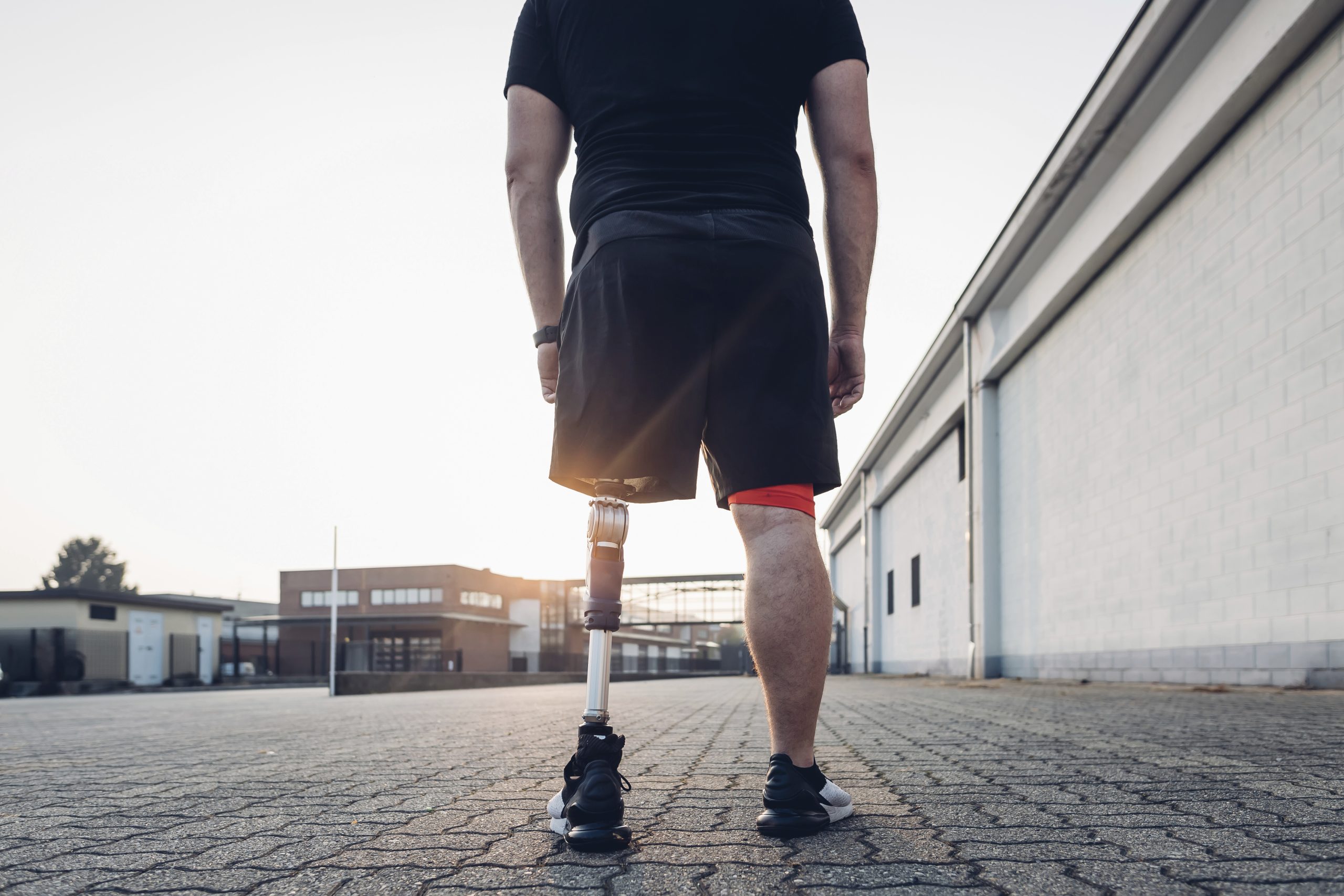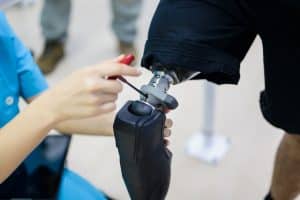Updated: August 25, 2025. Originally published December 2024.
The VA clothing allowance is a vital benefit that helps U.S. veterans finance the hidden costs of living with service-connected disabilities. Prosthetic devices, orthopedic braces, and VA-prescribed skin medications often cause wear, tear, or staining on everyday clothing, from a knee brace fraying your jeans to a skin cream leaving permanent marks on shirts.
To ease this burden, the Department of Veterans Affairs provides the VA clothing allowance, an annual, tax-free clothing allowance that ensures veterans don’t have to shoulder the expense of replacing clothes damaged by service-connected disabilities and related medical needs.
This comprehensive guide covers everything you need to know about the VA clothing allowance 2025 — eligibility rules, qualifying devices and medications, payment rates, deadlines, and the application process.
Quick Fact: In 2025, eligible veterans can receive up to $1,024.50 per approved device or medication — and you may qualify for up to four allowances per year if multiple devices or medications damage different types of clothing.
See official VA Clothing Allowance details here.
Table of Contents
What Is the VA Clothing Allowance?
The VA clothing allowance is an annual benefit provided by the Department of Veterans Affairs to eligible veterans who experience wear and tear on clothing caused by:
- Prosthetic devices (e.g., artificial limbs, wheelchairs, or rigid braces)
- Orthopedic appliances (e.g., back, knee, or ankle supports)
- VA-prescribed creams or ointments for service-connected skin conditions that irreparably stain or damage clothing
This VA benefit ensures veterans don’t have to bear the full cost of prematurely replacing clothes damaged by their necessary medical treatments or equipment.
For many veterans, this clothing allowance isn’t just financial assistance — it’s support for quality of life and dignity.
VA Clothing Allowance 2025 at a Glance
|
Benefit |
Details for 2025 |
|
Annual Payment Amount |
$1,024.50 per approved device/medication |
|
Maximum Allowances |
Up to 4 per year |
|
Application Deadline |
August 1, 2025 |
|
Payment Window |
September 1 – October 31, 2025 |
|
Form Required |
VA Form 10-8678 |
|
Recurring Payments |
Automatic if devices/medications haven’t changed |
|
Contact VA |
1-800-827-1000 or VA.gov |
Who Is Eligible for the VA Clothing Allowance?
Not all veterans automatically qualify. Eligibility under 38 CFR § 3.810 depends on three key factors:
1. You Have a Service-Connected Disability
To qualify, you must have a disability recognized by the VA as service-connected under 38 U.S.C. §§1110/1131 or be compensated as if service-connected under 38 U.S.C. §1151.
For example:
- A spinal injury sustained in active duty requiring a rigid back brace
- A combat injury that resulted in amputation and requires a prosthetic limb
- A chronic skin condition linked to military exposure treated with VA-prescribed ointments
2. Clothing Damage Requirement
Your device or medication must regularly and permanently damage clothing. Examples include:
- A prosthetic leg causing friction holes in pants
- A wheelchair armrest fraying shirts
- A VA-prescribed ointment staining shirts and blouses beyond repair
3. VA-Approved Prescription
The prosthetic, orthopedic appliance, or skin medication must be provided or approved by the VA. Over-the-counter products or non-prescribed braces don’t qualify unless your VA provider authorizes them for treatment.
How Many VA Clothing Allowances Can You Receive?
Under 38 CFR § 3.810, the number of annual VA clothing allowances you qualify for depends on how many devices or medications you use and how they affect your clothing:
- One Clothing Allowance – If you use a single VA‑approved prosthetic, orthopedic appliance, wheelchair, or prescribed skin medication that permanently damages one type of outer garment, you’re eligible for one annual payment.
- Multiple Allowances – If you use multiple qualifying devices or medications and each one damages a different type of outer garment (for example, pants and shirts), you may receive a separate allowance for each.
- Two Allowances for the Same Garment Type – Under § 3.810(a)(3)), if you use multiple devices or medications that together cause increased wear or damage to the same garment type, you may qualify for two allowances.
Learn more on VA.gov.
What Items Qualify for VA Clothing Allowance
The VA clothing allowance covers only outer garments that are regularly and permanently damaged. Approved clothing includes:
Shirts and Blouses
Qualify for the VA clothing allowance when sleeves, shoulders, or chest are regularly and permanently damaged by prosthetic devices, orthopedic braces, crutches, or prescribed topical skin medications. Examples include frayed cuffs from a forearm prosthesis or set-in ointment stains that don’t wash out.
Pants and Jeans
Eligible if knees, thighs, or waistbands get persistent wear, tears, grease marks, or discoloration from leg prosthetics, orthopedic braces, wheelchair parts, or topical meds. Frequent friction or metal contact that permanently damages denim or chinos can support your VA clothing allowance claim.
Skirts and Dresses
Covered when hems, hips, or waist areas are consistently ripped, snagged, or stained by braces, prosthetic hardware, or medication transfer. Regular, permanent damage to these outer garments is exactly what the VA clothing allowance covers.
Shorts
Qualify if daily use with leg braces or prosthetics causes persistent abrasion, holes, or residue from prescribed creams. Summer wear that is repeatedly and permanently damaged still counts under the VA clothing allowance.
Jackets and Coats
Eligible when sleeves, cuffs, collars, or torso areas get worn through, torn, or stained by shoulder/arm prostheses, crutch tips, or skin medications. Heavy outerwear that’s regularly damaged in cold or wet weather still counts as a covered outer garment.
Specialized Adaptive Clothing
Adaptive shirts, pants, or outerwear with features like hook-and-loop closures qualify when they are directly and repeatedly damaged by medical devices or prescribed skin treatments. If friction, snagging hardware, or medication staining makes the garment permanently unusable, it meets VA clothing allowance standards.
These items qualify because they are directly exposed to friction, staining, or damage from medical devices and skin medications.
Items Not Covered
- Shoes and orthopedic shoe inserts
- Hats, scarves, and gloves
- Underwear and socks
Example: If your knee brace wears holes in multiple pairs of jeans each year, your jeans qualify under the VA clothing allowance. However, socks damaged by shoe inserts would not.
Do Orthopedic Shoes or Inserts Qualify for VA Clothing Allowance?
Veterans often ask whether VA orthopedic shoes qualify. While the VA may issue orthopedic shoes if medically necessary, shoes and inserts are excluded from clothing allowance eligibility because they typically don’t cause damage to outer garments.
Why?
Because the purpose of the VA clothing allowance is to cover outer garments that experience regular wear and tear. Shoes and inserts are considered separate medical items and rarely cause qualifying clothing damage.
Tip: If your orthopedic shoes include leg or ankle braces that cause pants to wear out, the brace itself, not the shoe, may make you eligible for a clothing allowance.
List of VA-Approved Medications That May Stain or Damage Clothing
If the VA has prescribed creams, ointments, or gels for your service-connected skin conditions, you may qualify if they permanently stain, bleach, or weaken clothing fibers.
Here is the VA clothing allowance medication list as revised on 07/25/2025:
|
Medication Type |
Examples |
Why It Qualifies |
|
Topical Antivirals |
Acyclovir 5% Oint |
Ointment base may stain clothing |
|
Topical Antiperspirants |
Aluminum Hexahydrate 20% (Drysol, Hypercare, Xerac AC) |
Can leave stains/residue on fabrics |
|
Antifungals |
Amphotericin B (Fungizone), Ciclopirox 8% Top Soln, Clioquinol |
May discolor or stain clothing and fabrics |
|
Antipsoriatics |
Anthralin (Dritho-Scalp, Psoriatec), Calcipotriene (Dovonex), Halobetasol, Coal Tar (all topical forms) |
Known to stain skin, hair, and clothing |
|
Antibiotics (Topical) |
Bacitracin/Polymyxin Combo, Bacitracin/Neomycin/Polymyxin Combo, Mupirocin 2% Oint |
Due to polymyxin component or ointment base |
|
Dermatologic Agents (Acne Treatments) |
Benzoyl Peroxide (2.5%, 5%, 10% gels/washes) |
Can bleach or discolor clothing and hair |
|
Skin Protectants/Colorants |
Castellani Colorless Paint |
Stains clothes and skin |
|
Antiseptics/Disinfectants |
Chlorhexidine Gluconate Liquid, Povidone Iodine 10% (Ointment & Solution) |
Cause staining of fabrics and skin; iodine stains removable only with special stain remover |
|
Fluorescent Dyes |
Fluorescein Ophthalmic, Fluorescein/Proparacaine, Benoxinate HCl/Fluorescein Na, Rose Bengal Sodium |
Dye-based; stain clothing and skin |
|
Antiparkinson Agents |
Apomorphine (Apokyn) |
May cause staining |
|
Topical Antipruritics |
Crotamiton 10% Cream (except Eurax brand) |
Stains unless using specific non-staining brand |
|
Antimalarials/Antimicrobials |
Lindane 1% (Kwell) |
May leave residue/stains |
|
Anti-inflammatory (GI/Rectal) |
Mesalamine Suppository |
Can soil/stain clothing |
|
Antibiotics – Tetracyclines |
Minocycline (HCl topical), Tetracycline Ointment |
Known to cause staining of fabrics |
|
Depigmenting Agents |
Hydroquinone 3.3% Solution, Hydroquinone 4% Cream, Hydroquinone/Padimate-O Cream |
Can bleach or stain clothing |
|
Antineoplastic/Antimitotic Agents |
Podofilox 0.5% Soln (Condylox), Clobetasol Propionate ≥1% (Temovate, Olux) |
May damage or stain fabrics |
|
Sunscreens |
Para-Amino Benzoic Acid (PABA) SPF 30 lotions |
Stains and discolors fabrics |
|
Shampoos/Antiseborrheic Agents |
Selenium Sulfide 2.5% Lotion/Shampoo |
Stains fabrics and discolor hair |
|
Caustic/Reactive Agents |
Silver Nitrate |
Strongly stains fabrics permanently |
View the complete VA clothing allowance medication list 2025 or contact your VA prosthetics department.
What Knee Braces, Prosthetics, and Orthotic Devices Qualify?
The VA uses a PSAS-published guide to HCPCS (Healthcare Common Procedure Coding System) device codes as a guide in determining eligibility for the clothing allowance. All decisions are made case-by-case based on evidence of actual clothing damage.
Eligible devices must be:
- Prescribed for long-term use (greater than 1 year), and
- Have exposed joints or rigid materials that can reasonably cause clothing damage.
1. Lower Limb Orthoses
Knee Orthoses (KO)
- L1820, L1831, L1832, L1833, L1834, L1836
- L1840, L1843, L1844, L1845, L1846, L1847, L1848
Ankle-Foot Orthoses (AFO)
- L1900, L1910, L1920, L1930, L1932
- L1940, L1945, L1950, L1951, L1960
- L1970, L1971, L1980, L1990
Knee-Ankle-Foot Orthoses (KAFO)
(All KAFO designs may be considered, even if not listed)
- L2000, L2005, L2006 (new; established effective October 1, 2020, under the CMS decision on HCPCS coding)
- L2010, L2020, L2030
- L2034, L2036, L2037, L2038
Hip-Knee-Ankle-Foot Orthoses (HKAFO)
(All HKAFO designs may be considered, even if not listed)
- L2040, L2050, L2060, L2070, L2080, L2090
- K1007 (established effective October 1, 2020, per the CMS decision on HCPCS K1007)
Hip Orthoses (HO)
- L1686, L1690, L1845
2. Spinal Orthoses
Thoraco-Lumbo-Sacral Orthoses (TLSO)
- L0458, L0460, L0462, L0464
- L0466, L0468, L0470
- L0472, L0480
- L0482, L0484, L0486, L0488
- L0490, L0491, L0492
Cervical-Thoraco-Lumbo-Sacral Orthoses (CTLSO)
- L0700, L0710
- L0810, L0820, L0830
Scoliosis Orthoses
- L1000, L1200, L1300
3. Upper Limb Orthoses
Shoulder Orthoses (SO)
- L3674
Elbow/Elbow-Wrist-Hand/Elbow-Wrist-Hand-Finger Orthoses (EO, EWHO, EWHFO)
- L3720, L3730, L3740
- L3760, L3762, L3763, L3764, L3765, L3766
Shoulder-Elbow-Wrist-Hand Orthoses (SEWHO/SEWHFO)
- L3960, L3961, L3962, L3967, L3971, L3973
- L3975, L3976, L3977, L3978
4. Prosthetics
Lower Limb Prosthetics
- Any Veteran with a service-connected amputation proximal to the toes who wears a prosthesis.
- Eligibility should be reviewed at least every 5 years.
Upper Limb Prosthetics
- Any Veteran with a service-connected amputation proximal to the fingers who wears a prosthesis.
- Eligibility should be reviewed at least every 5 years.
Exclusions
- Cervical orthoses are excluded (usually for short-term use).
- Lumbosacral orthoses are generally excluded (most are off-the-shelf with padded coverage).
- Wrist-hand-finger orthoses are excluded (rarely cause clothing damage).
- Velcro straps or the need for different-sized clothing are not factors for eligibility.
Veterans may still qualify if they can show evidence of clothing damage caused by a prescribed orthotic device not on this list.
Example: If you use a spinal orthosis (TLSO) that causes fabric wear on shirts and coats, you may qualify for one or even two clothing allowances — one for upper-body garments and another for lower-body garments.
How Much Is the Current VA Clothing Allowance Rate?
For 2025, the VA annual clothing allowance is $1,024.50 per qualifying device or medication (Rate effective Dec 1, 2024 for the 2025 benefit year). Veterans can receive up to four allowances annually if multiple approved devices or medications damage separate types of clothing.
See the current Special Benefit Allowance Rates.
Example Scenario:
- You use a prosthetic leg that damages your pants
- You also use a skin medication that stains your shirts
- You could qualify for two separate allowances, totaling $2,049.
How to Apply for VA Clothing Allowance
The application period for the 2025 VA clothing allowance has already closed (deadline: August 1, 2025). If you missed the deadline, don’t worry, you can prepare early for next year.
Here’s how to apply for the 2026 VA clothing allowance when the window opens:
Step 1 — Get VA Form 10-8678
Download the Application for Annual Clothing Allowance here:
This form can be downloaded directly from va.gov. Instructions for completing and submitting the form are included on the website.
Step 2 — Submit Your Application
You have four options:
Online: Submit via My HealtheVet secure messaging or AccessVA QuickSubmit.
Mail:
Department of Veterans Affairs
Claims Intake Center
PO Box 4444
Janesville, WI 53547-4444
Fax: 844-531-7818 (U.S.) | 248-524-4260 (Overseas)
In-Person: Hand-deliver to your local VA Prosthetics and Sensory Aids Service department.
Step 3 — Meet the Deadline
Submit your form no later than August 1, 2026 to receive your payment.
If you need assistance, local Veteran Service Officers (VSOs) are available to guide you through the application process. You can find a VSO near you on va.gov or by searching for “Veteran Service Officer” in your county.
When Will VA Clothing Allowance Be Paid in 2025?
Payments for the VA clothing allowance 2025 are issued once per year after the application deadline. If your application is approved by August 1, 2025, you can expect payment between September 1 and October 31, 2025.
Funds are typically sent via direct deposit if your banking information is updated in VA records. Otherwise, you’ll receive a paper check by mail.
If you’ve already been approved in prior years and your devices or medications haven’t changed, the VA will automatically process your payment within the same timeframe — no annual reapplication needed unless you add new qualifying items.
Do You Need to Reapply Every Year?
- No, you don’t need to reapply if your qualifying device or VA‑prescribed medication hasn’t changed, as Public Law 117‑328 (Dec 29, 2022) ensures your annual clothing allowance payments continue automatically once approved.
- Yes, if you have added new qualifying devices or additional medications, you must submit a new VA Form 10-8678 for clothing allowance.
Denied Claims
Not all applications are approved. For instance, simple knee sleeves or basic foot inserts are often denied. If your claim is denied, it may be helpful to:
- Consult with your local prosthetic department.
- Request a list of qualifying devices or medications to ensure your item is included.
- Seek assistance from a VSO to strengthen your application.
Contacting the VA
If you have additional questions or need clarification, you can contact the VA directly at their toll-free number: 1-800-827-1000. The prosthetic department at your local VA Medical Center is another valuable resource for specific inquiries.
Additional Resources
For more detailed information, veterans are encouraged to visit va.gov and explore the “Disability” and “Special Claims” sections. These pages provide comprehensive guidance on eligibility, application procedures, and points of contact.
Pro Tips for Veterans Applying for VA Clothing Allowance 2026
The deadline for the 2025 clothing allowance (August 1, 2025) has already passed, but you can prepare early for 2026. The following steps can make the VA clothing allowance process faster and smoother.
- Mark Your Calendar for Next Year: Set a reminder to submit VA Form 10-8678 well before July next year to avoid delays and give the VA plenty of time to review your application.
- List All Qualifying Items: Be thorough when completing the form. Include every prosthetic, orthopedic device, and prescribed skin medication that causes clothing damage. Missing items could mean reduced benefits.
- Keep Documentation: Maintain copies of your prescriptions, device details, HCPCS codes, and even photographs showing clothing damage. These records strengthen your claim and make appeals easier if needed.
- Consult the VA Prosthetics Department: Your local Prosthetics and Sensory Aids Service (PSAS) can confirm eligibility, explain device coverage, and guide you through the application process.
Final Thoughts
The VA Clothing Allowance is a vital benefit that supports veterans by helping to replace clothing damaged by service-connected devices or medications. While not every veteran will qualify, understanding the eligibility criteria and application process can help ensure that those who are eligible receive this financial assistance. If you’re a veteran who might benefit from this program, don’t hesitate to apply or seek help from a VSO to navigate the process.
By taking advantage of the resources and support available, you can make the most of this valuable benefit and reduce the financial burden associated with clothing damage caused by your service-connected needs.
FAQs About VA Clothing Allowance
What is the VA clothing allowance payment amount in 2025?
In 2025, the VA clothing allowance is $1,024.50 per approved device or medication, with up to four allowances per year.
Do shoe inserts qualify for the VA clothing allowance?
Shoe inserts and orthopedic shoes do not qualify for the VA clothing allowance because they typically don’t damage outer garments.
Can I get the VA clothing allowance for a back brace?
A VA-prescribed rigid back brace may qualify for the clothing allowance if it regularly causes permanent damage to shirts, jackets, or other outer garments.
Does a knee brace make me eligible for the VA clothing allowance?
Yes, VA-approved knee braces with exposed joints or rigid parts that wear out pants or jeans qualify for the clothing allowance.
How can I check the status of my VA clothing allowance?
If you have been approved previously and your devices or medications haven’t changed, your allowance renews automatically; otherwise, you can check your status through VA.gov or by calling 1-800-827-1000.
What creams qualify for the VA clothing allowance?
Common examples include Tacrolimus, Triamcinolone, Benzoyl Peroxide, Calcipotriene, anthralin, mupirocin, hydroquinone, silver nitrate, and others that cause permanent stains or fabric damage.
When does the VA clothing allowance get paid?
Payments are distributed between September 1 and October 31, 2025.
How many allowances can I get per year?
Veterans can receive up to four clothing allowances every year if multiple devices or medications that wear out or damage different kinds of clothing.
What if my claim is denied?
You can appeal the decision through the VA. Call 1-800-827-1000 for assistance.
Also read: Raynaud’s Disease and VA Disability
At Prestige Veteran Medical Consulting, a veteran-owned company, we specialize in Independent Medical Opinions (IMOs) known as Nexus letters.
Our purpose is to empower YOU, the veteran, to take charge of your medical evidence and provide you with valuable educational tools and research to guide you on your journey.
Understanding the unique challenges veterans face, our commitment lies in delivering exceptional service and support.
Leveraging an extensive network of licensed independent medical professionals, all well-versed in the medical professional aspects of the VA claims process, we review the necessary medical evidence to incorporate in our reports related to your VA Disability Claim.
Prestige Veteran Medical Consulting is not a law firm, accredited claims agent, or affiliated with the Veterans Administration or Veterans Services Organizations. However, we are happy to discuss your case with your accredited VA legal professional.













